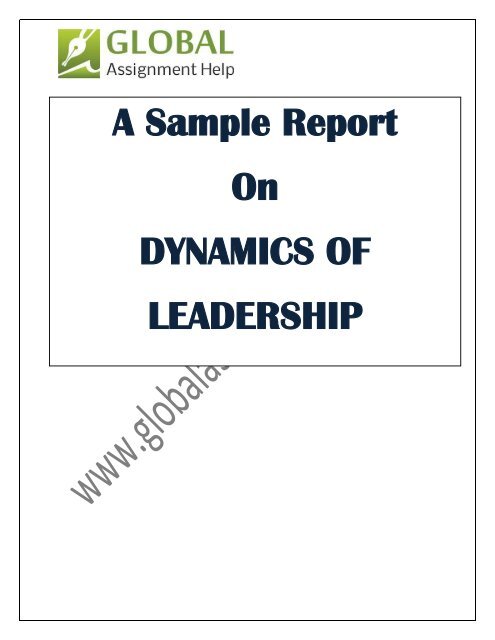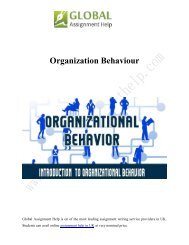Sample Report on Dynamics Of Leadership by Expert Writers
Leadership is the ability that is required in an organization that facilitates the proper flow of information and it also ensures proper and efficient delegation of authorities. The main function of leader is to maximize efficiency and this thereby helps in achieving objectives.To Know more about Dynamics Of Leadership read this document.
Leadership is the ability that is required in an organization that facilitates the proper flow of information and it also ensures proper and efficient delegation of authorities. The main function of leader is to maximize efficiency and this thereby helps in achieving objectives.To Know more about Dynamics Of Leadership read this document.
You also want an ePaper? Increase the reach of your titles
YUMPU automatically turns print PDFs into web optimized ePapers that Google loves.
A <str<strong>on</strong>g>Sample</str<strong>on</strong>g> <str<strong>on</strong>g>Report</str<strong>on</strong>g><br />
On<br />
DYNAMICS OF<br />
LEADERSHIP
TABLE OF CONTENTS<br />
INTRODUCTION .......................................................................................................................... 3<br />
ROLE AND PROCESS OF LEADERSHIP .................................................................................. 1<br />
POWER AND INFLUENCE OF LEADERSHIP .......................................................................... 4<br />
WAYS TO MOTIVATE EMPLOYEES ........................................................................................ 9<br />
DEVELOPMENT AND EFFICIENCY OF TEAM ..................................................................... 10<br />
ORGANIZATIONAL CHANGE ................................................................................................. 11<br />
LEADERSHIP STYLES .............................................................................................................. 13<br />
COMPLETE PARTICIPATION .................................................................................................. 15<br />
CONCLUSION ............................................................................................................................. 16<br />
REFERENCES ............................................................................................................................. 17
TABLE OF FIGURES<br />
Figure 1Hill's leadership model ...................................................................................................... 3<br />
Figure 2Lewins model .................................................................................................................. 12
INTRODUCTION<br />
<strong>Leadership</strong> is the ability that is required in an organizati<strong>on</strong> that facilitates the proper flow<br />
of informati<strong>on</strong> and it also ensures proper and efficient delegati<strong>on</strong> of authorities. In a<br />
management, motivati<strong>on</strong> is required so that to persuade the employees to play an important role<br />
in the workplace. Leader plays an important role in an organizati<strong>on</strong> as it provides proper<br />
guidance to its subordinates. An efficient work envir<strong>on</strong>ment helps in sound and stable growth<br />
(Adair, 2010). The main functi<strong>on</strong> of management is leadership which helps to maximize<br />
efficiency and this there<strong>by</strong> helps in achieving objectives.<br />
<strong>Leadership</strong> and motivati<strong>on</strong> are interrelated to each other as leaders are the <strong>on</strong>ly pers<strong>on</strong>s<br />
that motivate the employees so that to increase efficiency in performance level. In this present<br />
study, researcher has chosen the ‘U’ care organizati<strong>on</strong> which is a nati<strong>on</strong>al charity and having<br />
regi<strong>on</strong>al manager in their firm. Their role is to co-ordinate a small group of full time staff and<br />
volunteers. This report presented some objective <strong>on</strong> the ground of leadership which has to be<br />
fulfilled. Keeping the objectives in mind role, process, power, pers<strong>on</strong>ality, team development,<br />
style and many more n respect of leadership will be discussed (Adair, 2011). At last a c<strong>on</strong>clusi<strong>on</strong><br />
will be drawn out which provide an essence of this report.<br />
ROLE AND PROCESS OF LEADERSHIP<br />
It is required to motivate the employees so that to increase job satisfacti<strong>on</strong> and it also<br />
encourages productivity. Both the leader and the management of U care organizati<strong>on</strong> play a<br />
significant role in employee motivati<strong>on</strong>. A leader motivates the employees in such a way that it<br />
combines organizati<strong>on</strong>al goals with individual goals (Adams, 2012). The role of leaders and<br />
managers has been explained as under:<br />
Understand the factors that motivates employees<br />
Create a fair system<br />
Increases the efficiency in performance<br />
Toll Free No. +44 203 3555 345<br />
Mail Us: help@globalassignmenthelp.com<br />
Global Assignment Help Provides Professi<strong>on</strong>al <strong>Leadership</strong> Assignment Help to student<br />
of colleges and university at an affordable price.
Builds effective communicati<strong>on</strong><br />
Helps to get high competitive advantage<br />
Resolves the issues and c<strong>on</strong>flicts<br />
Fair means of reward system (Alvess<strong>on</strong>, 2012)<br />
Improves the productivity of employee and this there<strong>by</strong> helps in organizati<strong>on</strong>al productivity<br />
<str<strong>on</strong>g>Sample</str<strong>on</strong>g> <str<strong>on</strong>g>Report</str<strong>on</strong>g> <strong>on</strong> <strong>Dynamics</strong> <strong>Of</strong> <strong>Leadership</strong><br />
For Complete Assignment<br />
Kindly C<strong>on</strong>tact us at:<br />
help@globalassignmenthelp.com<br />
<strong>Leadership</strong> is not an easy task to perform, Infect he/she is the representative of group or<br />
organizati<strong>on</strong>. Their roles and resp<strong>on</strong>sibilities are so high. Roles that they follow are: leaders are<br />
liable to manage the operati<strong>on</strong>s of team (Adair, 2010). In a group or team leader delegate<br />
authorities to their member and work has to be d<strong>on</strong>e accordingly. Leader provides proper<br />
guidance, supervisi<strong>on</strong> and cooperati<strong>on</strong> to their team members if they find any problem in any<br />
task. Last is leader deciding the fund that has been required to carry out the work means they<br />
prepare the budget?<br />
Toll Free No. +44 203 3555 345<br />
Mail Us: help@globalassignmenthelp.com<br />
Global Assignment Help Provides Professi<strong>on</strong>al <strong>Leadership</strong> Assignment Help to student<br />
of colleges and university at an affordable price.
The above menti<strong>on</strong>ed chart <strong>on</strong> leadership model displays four layers or steps in the team<br />
leadership model. Those four steps are:<br />
At the top layer, all members of a team perform and the organizati<strong>on</strong> evaluates the<br />
performance of the team and determines the effectiveness of the team.<br />
There is an internal and external analysis of the leadership level at the sec<strong>on</strong>d stage.<br />
The third level determines the task, relati<strong>on</strong>al and envir<strong>on</strong>mental aspects. At this stage the<br />
leaders are required to identify the goals and structure of the organizati<strong>on</strong> so that to organize<br />
training sessi<strong>on</strong>s Figure 1Hill's leadership model accordingly (Eacott,<br />
2010).<br />
(Source Bowerman, 2003)<br />
The process of<br />
leadership is not an easy<br />
Toll Free No. +44 203 3555 345<br />
Mail Us: help@globalassignmenthelp.com<br />
Global Assignment Help Provides Professi<strong>on</strong>al <strong>Leadership</strong> Assignment Help to student<br />
of colleges and university at an affordable price.
task. <strong>Leadership</strong> is the art where<strong>by</strong> a leader <strong>by</strong> his performance influences others. It is required<br />
for the leader to make number of followers so that to bring effective coordinati<strong>on</strong> in an<br />
organizati<strong>on</strong>. In a U care organizati<strong>on</strong>, a number of activities are there and it is the main duty of<br />
the leader to employ the employee in that place where they can put their best efforts. It is a<br />
process where<strong>by</strong> the subordinates of an organizati<strong>on</strong> follow the given directi<strong>on</strong>s framed <strong>by</strong> their<br />
leader. <strong>Leadership</strong> is defined as the process where every individual is suppose to follow their<br />
immediate leader and leader lead the group towards the accomplishment of comm<strong>on</strong> objective<br />
(Finkelestein and et.al., 2009). Management is more transacti<strong>on</strong>al whereas leadership is more<br />
visi<strong>on</strong>ary or dynamic. In the process of leadership, leader required an art which can help the<br />
individual to achieve the objectives of organizati<strong>on</strong> as well as individual objectives (Bowerman,<br />
2003).<br />
POWER AND INFLUENCE OF LEADERSHIP<br />
Leader is not an ordinary pers<strong>on</strong>, he have to have some special skills that differentiate<br />
them with others employees. He/she is the pers<strong>on</strong> who poses some special power that make them<br />
called as leader. Power and influence of leader can be seen in following points shared below:<br />
The management of U care organizati<strong>on</strong> would be more competitive enough if the power of<br />
regi<strong>on</strong>al manger follows the steps shared below: (Gitlow, 2004)<br />
Cultural challenges<br />
In an organizati<strong>on</strong> there various employees that follow different culture and this is the<br />
main reas<strong>on</strong> that creates issues in an organizati<strong>on</strong>. It is required for the U care organizati<strong>on</strong> to<br />
follow the culture of the country so that it does not affect the interest of the society (Griffith and<br />
et.al., 2009).<br />
Toll Free No. +44 203 3555 345<br />
Mail Us: help@globalassignmenthelp.com<br />
Global Assignment Help Provides Professi<strong>on</strong>al <strong>Leadership</strong> Assignment Help to student<br />
of colleges and university at an affordable price.
Ethical challenges<br />
It has been seen in several cases that in order to get high appreciati<strong>on</strong> for their<br />
organizati<strong>on</strong> and even funds, organizati<strong>on</strong>s generally involved in unethical practices. So regi<strong>on</strong>al<br />
manager have to take care that under their supervisi<strong>on</strong> this should not be d<strong>on</strong>e and should be<br />
d<strong>on</strong>e with full ethical means.<br />
<str<strong>on</strong>g>Sample</str<strong>on</strong>g> <str<strong>on</strong>g>Report</str<strong>on</strong>g> <strong>on</strong> <strong>Dynamics</strong> of <strong>Leadership</strong><br />
For Complete Assignment<br />
Kindly C<strong>on</strong>tact us at:<br />
help@globalassignmenthelp.com<br />
Difficulty in decisi<strong>on</strong> making<br />
In an organizati<strong>on</strong>, there are various employees and it is required for the management to<br />
take opini<strong>on</strong>s from its employees so that to get suitable advices (Finkelestein and et. al., 2009).<br />
Hasty decisi<strong>on</strong>s leads to improper functi<strong>on</strong>s and this there<strong>by</strong> affects the decisi<strong>on</strong> making ability.<br />
Effectiveness is required so that to take correct decisi<strong>on</strong>s. Power and influence can be seen best<br />
out there <strong>by</strong> molding the behavior of employees towards the comm<strong>on</strong> aim of organizati<strong>on</strong> and<br />
further persuade them to become leader’s supportive role (Holt and et.al., 2003).<br />
Gender issues<br />
Toll Free No. +44 203 3555 345<br />
Mail Us: help@globalassignmenthelp.com<br />
Global Assignment Help Provides Professi<strong>on</strong>al <strong>Leadership</strong> Assignment Help to student<br />
of colleges and university at an affordable price.
A lot many issues have been seen related to the gender biasness. Equal importance should<br />
be given to all the employees so that to remove discriminati<strong>on</strong>. But if the leader with ful<br />
c<strong>on</strong>fidence educate their employees to not to raise such issues as they are equal for this<br />
organizati<strong>on</strong>, then the regi<strong>on</strong>al manager can more effectively direct the operati<strong>on</strong>s and<br />
performance of their volunteer and staff (Hughes and Beatty, 2011).<br />
Improper training<br />
There are many employees in a U care organizati<strong>on</strong> that requires training as medical<br />
services cannot be granted without having proper knowledge (Finkelestein and et.al., 2009).<br />
Leader can shoe their power to choose employees for training whose performance are not up to<br />
the mark because carefulness in their work may dishearten the underprivileged young people.<br />
Efficient training sessi<strong>on</strong>s are required so that to increase the efficiency of the employees and<br />
this can help the organizati<strong>on</strong> to deliver better services (Kanter, 2004).<br />
Time management<br />
Time management is the essential task that requires efficiency. It is the main issue with<br />
all the managers that they are not able to manage the activities. So in order to remove the issues,<br />
they have to make best use of their power in assessing training regards to time management<br />
(Hughes and Beatty, 2011).<br />
Moreover, al<strong>on</strong>g with the above discussi<strong>on</strong> power of leadership can also be defined<br />
through this chart which explains the power of leadership at each level, they are as under:<br />
Toll Free No. +44 203 3555 345<br />
Mail Us: help@globalassignmenthelp.com<br />
Global Assignment Help Provides Professi<strong>on</strong>al <strong>Leadership</strong> Assignment Help to student<br />
of colleges and university at an affordable price.
Pers<strong>on</strong>hood<br />
People Developer<br />
Producti<strong>on</strong><br />
Permissi<strong>on</strong><br />
Positi<strong>on</strong><br />
Level 1 – Positi<strong>on</strong> (Rights)<br />
It is the most basic level of leadership where the people have to follow the order of their<br />
immediate leader. This level drives the fellowship because of authority and positi<strong>on</strong> that leaders<br />
possess in their team. Without these authority he/she is not able to lead their team (Mulki and<br />
et.al., 2011). In this level of leadership it is delegated <strong>on</strong> the ground of hierarchy bass and is<br />
applied <strong>on</strong>ly to lower level of an organizati<strong>on</strong>.<br />
Level 2 – Permissi<strong>on</strong> (Relati<strong>on</strong>ship)<br />
This level is completely opposite of former level. As in this level leader tries to make<br />
relati<strong>on</strong> with people around them. Their main of building such relati<strong>on</strong>ship is to enhance their<br />
capability of leadership, this relati<strong>on</strong>ship let people to follow their leader as p their interest. This<br />
relati<strong>on</strong>ship helps leaders to be like <strong>by</strong> their fellow members. So the essence of this level is to<br />
build a healthy relati<strong>on</strong>ship with their members (Osborne and Brown, 2005).<br />
Level 3 – Producti<strong>on</strong> (Results)<br />
In the level of this leadership, leader always try to perform with the best of their efforts<br />
and wants to c<strong>on</strong>tribute outstanding in their organizati<strong>on</strong>. This is basically d<strong>on</strong>e under this level.<br />
This achievement lead the leader in their group and boost up their c<strong>on</strong>fidence and inoculate<br />
positivity in their behavior and relati<strong>on</strong> (Mulki and et.al., 2011). In this level whatever the<br />
challenge is given to leader, they make it happen and perform with their best. This makes the<br />
Toll Free No. +44 203 3555 345<br />
Mail Us: help@globalassignmenthelp.com<br />
Global Assignment Help Provides Professi<strong>on</strong>al <strong>Leadership</strong> Assignment Help to student<br />
of colleges and university at an affordable price.
organizati<strong>on</strong> ore successful <strong>on</strong>e and winning <strong>on</strong>e. This performance is highly enjoyed <strong>by</strong> the<br />
commercial organizati<strong>on</strong> when the results are being achieved <strong>on</strong> time (Schein, 2010).<br />
<str<strong>on</strong>g>Sample</str<strong>on</strong>g> <str<strong>on</strong>g>Report</str<strong>on</strong>g> <strong>on</strong> <strong>Dynamics</strong> of <strong>Leadership</strong><br />
For Complete Assignment<br />
Kindly C<strong>on</strong>tact us at:<br />
help@globalassignmenthelp.com<br />
Level 4 – People Development (Reproducti<strong>on</strong>)<br />
Under this phase of leadership model, members are suppose to follow their leader due to<br />
their c<strong>on</strong>tributi<strong>on</strong> in developing them in their carrier. Leader under this level believes to develop<br />
their fellow members to improve their working style and improve their efforts. By doing so they<br />
are actually developing their members in an organizati<strong>on</strong> and this makes the leader feel happy as<br />
their members are obeying their orders. These c<strong>on</strong>cerns for their members make the members<br />
and leader both happy and strengthen their relati<strong>on</strong>ship and people will follow them in future as<br />
well with full loyalty. This leadership form is seen in the world of academic (Storey, 2013).<br />
Level 5 – Pinnacle (Respect)<br />
Last but not the least, this step is defined as pers<strong>on</strong>hood step. In this stage people follow<br />
their leader because what he/she actually is and what he represents was totally differe4nt. In this<br />
step leader makes their own rule of doing the work and is work <strong>on</strong> the intuiti<strong>on</strong> to achieve single<br />
goal (Wart, 2012).<br />
Toll Free No. +44 203 3555 345<br />
Mail Us: help@globalassignmenthelp.com<br />
Global Assignment Help Provides Professi<strong>on</strong>al <strong>Leadership</strong> Assignment Help to student<br />
of colleges and university at an affordable price.
WAYS TO MOTIVATE EMPLOYEES<br />
Regi<strong>on</strong>al managers have to deal with many pers<strong>on</strong>alities in their organizati<strong>on</strong> and every<br />
pers<strong>on</strong>ality possesses different views and opini<strong>on</strong>s (Hughes and Beatty, 2011). In that case<br />
leadership plays an influential role in motivating the workforce in an organizati<strong>on</strong>. In order to<br />
increase the productivity and to motivate them for comm<strong>on</strong> goal, it is required to know about<br />
various theories. Here are some motivati<strong>on</strong>al theories that will be showing the importance of<br />
motivati<strong>on</strong> at workplace and help regi<strong>on</strong>al managers to tackle different pers<strong>on</strong>ality (C<strong>on</strong>cepts of<br />
<strong>Leadership</strong>, 2010).<br />
Maslow<br />
Maslow believed that the needs of an individual can be expressed in a hierarchical form<br />
where<strong>by</strong> different needs can be defined. The first need in the hierarchy is the basic needs such as<br />
food, cloth and shelter. After satisfying the basic needs, the level of motivati<strong>on</strong> changes and it<br />
moves towards the upper needs. Thus, <strong>by</strong> this Maslow suggest that it is required to identify the<br />
needs of employee so that to address them properly (Kotter, 2012). The five levels in need<br />
hierarchy are physiological, safety, social, esteem to self actualizati<strong>on</strong> needs.<br />
Herzberg<br />
The theory is based up<strong>on</strong> those facts that lead disappointment. There are several factors<br />
that demotivate the employees and the theory identifies the reas<strong>on</strong>s that results in dissatisfacti<strong>on</strong><br />
(Osborne and Brown, 2005). The main factors are c<strong>on</strong>cerned with the job of an employee. Other<br />
elements are those that affect the work performance and motivati<strong>on</strong> level. Motivati<strong>on</strong> at this<br />
stage is required so that to develop the growth aspects and also bring efficiency in work<br />
performance (<strong>Leadership</strong> and Strategy, 2011).<br />
Toll Free No. +44 203 3555 345<br />
Mail Us: help@globalassignmenthelp.com<br />
Global Assignment Help Provides Professi<strong>on</strong>al <strong>Leadership</strong> Assignment Help to student<br />
of colleges and university at an affordable price.
Cognitive theory<br />
Cognitive theory can be classified into three categories and such are equity, goal setting<br />
and expectancy theory. All the theory emphasizes <strong>on</strong> motivating employee <strong>by</strong> achieving the<br />
desired objectives (<strong>Leadership</strong> and Strategy, 2011).<br />
Power theory<br />
The theory focuses <strong>on</strong> employee empowerment in which opini<strong>on</strong>s must be taken from<br />
the employees at the time of decisi<strong>on</strong> making and it also states that proper delegati<strong>on</strong> of duties<br />
increases the opportunities of employee growth (Employee Commitment & Productivity Study,<br />
2011).<br />
DEVELOPMENT AND EFFICIENCY OF TEAM<br />
An organizati<strong>on</strong> can achieve productivity as well as effectiveness when having efficient<br />
team members. For the development of team, they have to go through five stages. Each stage is<br />
having its own importance in the development of team because they all are striving together for<br />
developing a str<strong>on</strong>g team. Such stages are menti<strong>on</strong>ed as under:<br />
Forming: Under this stage the group of people comes collected to perform the work for the<br />
accomplishment of comm<strong>on</strong> objective. The members introduced each other formally.<br />
Storming: At this stage, the organizati<strong>on</strong> combines the team members so that to build<br />
effective relati<strong>on</strong>ships. Coordinati<strong>on</strong> can be achieved at this stage (<strong>Leadership</strong> Traits, 2010).<br />
Norming: At this stage, the team members works with coordinati<strong>on</strong> so that to achieve<br />
organizati<strong>on</strong>al goals. At this stage, team members focus <strong>on</strong> achieving team objectives.<br />
Performing: At this stage, the team members integrate the work performance with<br />
organizati<strong>on</strong>al goals so that to identify the effectiveness and functi<strong>on</strong>ing of team members.<br />
Transforming: The volunteers of regi<strong>on</strong>al managers in U care were performing so well, that<br />
they c<strong>on</strong>sider it as <strong>on</strong>e of the most efficient team till now for the organizati<strong>on</strong>al development<br />
(Mumford and Gibs<strong>on</strong>, 2011).<br />
Toll Free No. +44 203 3555 345<br />
Mail Us: help@globalassignmenthelp.com<br />
Global Assignment Help Provides Professi<strong>on</strong>al <strong>Leadership</strong> Assignment Help to student<br />
of colleges and university at an affordable price.
At every stage motivati<strong>on</strong> is also required for the team members so that to retain efficient<br />
employees and skills in the organizati<strong>on</strong>. A group is different than a team. Team member focuses<br />
<strong>on</strong> achieving overall objectives of an organizati<strong>on</strong> whereas groups are formed for the purpose of<br />
achieving individual goals. Group dynamics refers to a set of behaviors and psychological<br />
processes in a social group (Employee Commitment & Productivity Study, 2011).<br />
ORGANIZATIONAL CHANGE<br />
Change is the rule of nature and no <strong>on</strong>e can resist the change. In the same way, it is<br />
applicable in organizati<strong>on</strong> as well where the management after a specific period of time brings<br />
the change in the process to meet the new trends of working in a competitive world. This change<br />
in an organizati<strong>on</strong> not <strong>on</strong>ly let the organizati<strong>on</strong> to match up with the new trend but also provides<br />
them a opportunity to get a edge over their competitor and lead them all (Murphy, 2008). But it<br />
is said that no organizati<strong>on</strong> can easily bring change in their organizati<strong>on</strong>. To cultivate this it they<br />
need to first perform a in-depth research that what change in required and where it is required<br />
and why it is required and what benefits they will get after the change. This all c<strong>on</strong>cepts has to be<br />
cleared from the side of management so that they can communicate this to their employees in a<br />
more specific and logical manner. Still people willed finitely result the change and this is can be<br />
very drastic in nature. So to overcome such problem, in our case regi<strong>on</strong>al managers have held<br />
resp<strong>on</strong>sible some volunteers which will be first educated about the change from the starting and<br />
will be educated about the positive implicati<strong>on</strong> of the change in their U care, so that in future<br />
they may not resist and can educate fresher’s in future that to how to bring the change and what<br />
are the positive side of change (Schein, 2010). Regi<strong>on</strong>al managers can follow the Lewins model<br />
of change which described as under:<br />
Toll Free No. +44 203 3555 345<br />
Mail Us: help@globalassignmenthelp.com<br />
Global Assignment Help Provides Professi<strong>on</strong>al <strong>Leadership</strong> Assignment Help to student<br />
of colleges and university at an affordable price.
Unfreeze Change Refreeze<br />
Figure 2Lewins model<br />
(Source: Nash and Hwang, 2012)<br />
Above shown was known as Lewins model which is widely used model in every<br />
organizati<strong>on</strong>. In our case a team is being hired to bring the change in U care and follows the<br />
following steps:<br />
A. Unfreeze: In this stage of Lewins model, organizati<strong>on</strong> or management put their efforts to<br />
educate their staff for bringing change into their organizati<strong>on</strong>. But it doesn’t seem to be an<br />
easy task, because people will definitely resist the change as they are molded in older style of<br />
working. For eliminate this, they have to be proper communicated that why the older style is<br />
being eliminated and why the new style is bringing. Drawbacks of earlier style also have to<br />
be communicated and the positive implicati<strong>on</strong>s of new process are communicated. This<br />
sessi<strong>on</strong> can possibly be d<strong>on</strong>e through educating and training sessi<strong>on</strong> (Pauleen, 2003). This<br />
stage comprises of more efforts and wear and tear that’s why it is also known as the most<br />
stressful stage in the Lewins model. In that stage employee’s value, belief and attitude has to<br />
be c<strong>on</strong>sidered and the main focus <strong>on</strong> these things <strong>on</strong>ly. This has to be handled so carefully<br />
that the employee’s value and belief may not get affected. These explanati<strong>on</strong> describe the<br />
unfreeze factor of Lewins model.<br />
Toll Free No. +44 203 3555 345<br />
Mail Us: help@globalassignmenthelp.com<br />
Global Assignment Help Provides Professi<strong>on</strong>al <strong>Leadership</strong> Assignment Help to student<br />
of colleges and university at an affordable price.
B. Change: Change phase in the Lewins, model is used to cultivate the change that has been<br />
decided <strong>by</strong> the organizati<strong>on</strong> or <strong>by</strong> the management of organizati<strong>on</strong>. The regi<strong>on</strong>al managers of<br />
U care were trying their best to bring change so as to protect their volunteers and staff and<br />
also to protect their envir<strong>on</strong>ment (Crossman, 2010). This change is not a machine that can be<br />
bring at any time, else it is a complete re-engineer of process which is being cultivated after<br />
imparting a proper training to employees, in the same way regi<strong>on</strong>al managers of U care are<br />
doing so <strong>by</strong> imparting proper and effective training to their volunteers and staff. This training<br />
sessi<strong>on</strong> let employees to educate that why these training is providing them, what benefit is<br />
going to be gain, what implicati<strong>on</strong> will they have. Answering to this questi<strong>on</strong> <strong>by</strong> the<br />
management prepare their staff mentally str<strong>on</strong>g and drive them towards the change and will<br />
force them to accept the change for further benefits in future (Densten, 2002).<br />
C. Refreeze: In the state of refreeze, it is being explained that when employees or people start<br />
accepting the change and working as per the changing procedure then the organizati<strong>on</strong> strat<br />
the process of refreezing. But just <strong>by</strong> molding them in a refreeze state is not an end, To make<br />
this process a successful <strong>on</strong>e U care have to c<strong>on</strong>tinuously educate their employees regarding<br />
the positive aspect of change and why this change is being cultivated in our organizati<strong>on</strong>.<br />
Moreover leader must celebrate the success of change with their employees or subordinates<br />
so that employees feel that this change was actually beneficial for them and for organizati<strong>on</strong><br />
(Eyal and Roth, 2011).<br />
LEADERSHIP STYLES<br />
Different styles of leadership have diverse kind of impact <strong>on</strong> strategic decisi<strong>on</strong> of an<br />
organizati<strong>on</strong> and every style has their own pros and c<strong>on</strong>s, some of them are discussed below:<br />
• Autocratic <strong>Leadership</strong> Style – In an autocratic style of leadership the in-charge pers<strong>on</strong> has<br />
total authority and c<strong>on</strong>trol over decisi<strong>on</strong> making. It is also known as authoritarian leadership<br />
as it clearly explains in the divisi<strong>on</strong> between workers and leaders. Leaders following this<br />
leadership trait do involve in employees in any kind of decisi<strong>on</strong> making and leaders have full<br />
Toll Free No. +44 203 3555 345<br />
Mail Us: help@globalassignmenthelp.com<br />
Global Assignment Help Provides Professi<strong>on</strong>al <strong>Leadership</strong> Assignment Help to student<br />
of colleges and university at an affordable price.
c<strong>on</strong>fidence with the decisi<strong>on</strong> making resp<strong>on</strong>sibility for organizati<strong>on</strong>s operating and strategic<br />
planning (Clark, 2010).<br />
<str<strong>on</strong>g>Sample</str<strong>on</strong>g> <str<strong>on</strong>g>Report</str<strong>on</strong>g> <strong>on</strong> <strong>Dynamics</strong> of <strong>Leadership</strong><br />
For Complete Assignment<br />
Kindly C<strong>on</strong>tact us at:<br />
help@globalassignmenthelp.com<br />
• Participative <strong>Leadership</strong> Style – In this style a leader motivates in team members to<br />
participate in the decisi<strong>on</strong> making process. In this team members feel motivated and<br />
encouraged and actively participate in the decisi<strong>on</strong> making areas. In such kind of style, leader<br />
take the final decisi<strong>on</strong> but al<strong>on</strong>g with that they also involve their team member in taking any<br />
decisi<strong>on</strong>. and their motivate creativity and tend to provide in job satisfacti<strong>on</strong> to the team<br />
members (Corapi, 2012).<br />
• Bureaucratic <strong>Leadership</strong> Style – These leaders work under <strong>by</strong> the book and they follow<br />
resp<strong>on</strong>sibilities and make sure that their team members follow procedure superficially. It is<br />
an appropriate style of leadership that is mainly preferable when employees undertake<br />
routine tasks (Nash and Hwang, 2012). During strategic decisi<strong>on</strong> making it is generally not<br />
much used because it is ineffective in teams and maximum of time bureaucratic leaders attain<br />
their positi<strong>on</strong> preferably because of their rules and not of their qualificati<strong>on</strong>s (Pike, 2003).<br />
Toll Free No. +44 203 3555 345<br />
Mail Us: help@globalassignmenthelp.com<br />
Global Assignment Help Provides Professi<strong>on</strong>al <strong>Leadership</strong> Assignment Help to student<br />
of colleges and university at an affordable price.
• Charismatic <strong>Leadership</strong> Style – It resembles much of transformati<strong>on</strong>al style of leadership as<br />
the leaders inspire enthusiasm am<strong>on</strong>g the team members and are very much energetic in<br />
motivating others to move ahead and achieve the ultimate goal. The leaders using this style<br />
are mostly focused <strong>on</strong> themselves and would not prefer to change anything. In organizati<strong>on</strong>al<br />
strategic decisi<strong>on</strong> making undertakes great resp<strong>on</strong>sibility and it leaders following charismatic<br />
leadership do not prefer in l<strong>on</strong>g commitment for a work (Densten, 2002).<br />
• Laissez – Faire <strong>Leadership</strong> Style – This involves in French phrase in it and it defines the way<br />
leaders facilitate their people to work <strong>on</strong> their own and this kind of leadership mostly occurs<br />
naturally and when managers do not have much of c<strong>on</strong>trol over their people or work. In this<br />
style leaders provide in their team members complete freedom to undertake their work and<br />
frame their own deadlines. Leaders <strong>on</strong>ly offer team support and advice at required point of<br />
time and it can be effective if the leader from time to time motivates subordinates and it leads<br />
to high job satisfacti<strong>on</strong> and enhanced performance of employees (Pauleen, 2003).<br />
COMPLETE PARTICIPATION<br />
To make the event successful <strong>on</strong>e, fund raising event calls for active participati<strong>on</strong> of the<br />
members of U care organizati<strong>on</strong> like their staff, regi<strong>on</strong>al leader and other volunteer. There active<br />
participati<strong>on</strong> can <strong>on</strong>ly lead them this event as a successful <strong>on</strong>e. Basically this activities are being<br />
d<strong>on</strong>e for special purpose that is to help under privileged people and the funds that is being<br />
collected is also for their purpose like for their medicine, for their livelihood and for their<br />
accommodati<strong>on</strong> (Crossman, 2010). Activities that are going to be held from the side of U care<br />
are raffles, street collecti<strong>on</strong>s, social fund raising events and local corporate sp<strong>on</strong>sorships. The<br />
efforts of volunteer and staff to perform these activities can be direct <strong>on</strong>ly <strong>by</strong> the regi<strong>on</strong>al<br />
managers of U care. With their guidance and support <strong>on</strong>ly their sub-ordinate will perform which<br />
in turn gives fruitful result to U care (Corapi, 2012). To facilitate the participati<strong>on</strong> of staff<br />
members and volunteers, leader should go for following points:<br />
Toll Free No. +44 203 3555 345<br />
Mail Us: help@globalassignmenthelp.com<br />
Global Assignment Help Provides Professi<strong>on</strong>al <strong>Leadership</strong> Assignment Help to student<br />
of colleges and university at an affordable price.
Manage motivati<strong>on</strong>: Being a leader it is required for him to arrange motivati<strong>on</strong> programs so<br />
that to encourage the employees for fund raising events.<br />
Creating c<strong>on</strong>fidence: It is essential for the leader to recognize the performances as this<br />
encourages them for participate in activities.<br />
Greater communicati<strong>on</strong>: Communicati<strong>on</strong> is required at each level as it maintains proper flow<br />
of informati<strong>on</strong>. With the help of effective communicati<strong>on</strong>, employees can able to take out the<br />
expected results of events (Feldman, 2013).<br />
CONCLUSION<br />
From the above discussi<strong>on</strong> it can be c<strong>on</strong>cluded that strategic leaders are mainly<br />
resp<strong>on</strong>sible for U care organizati<strong>on</strong> and can influence their staff and volunteers. These leaders<br />
establish different organizati<strong>on</strong>al structure, distribute resources and communicate their strategic<br />
visi<strong>on</strong> (<strong>Leadership</strong> and Strategy, 2011). Strategic leaders need to work in an uncertain<br />
envir<strong>on</strong>ment with highly complex issues that impact <strong>on</strong> firms. It is the skill that dominates in<br />
corporate leaders with more complex and increased uncertainty and an increased number of<br />
unintended outcomes.<br />
Toll Free No. +44 203 3555 345<br />
Mail Us: help@globalassignmenthelp.com<br />
Global Assignment Help Provides Professi<strong>on</strong>al <strong>Leadership</strong> Assignment Help to student<br />
of colleges and university at an affordable price.
REFERENCES<br />
Books and Journals<br />
Adair, E., 2010. Strategic <strong>Leadership</strong>: How to Think and Plan Strategically and Provide<br />
Directi<strong>on</strong>. Kogan Page Publishers.<br />
Adair, J., 2011. Effective Strategic <strong>Leadership</strong>. Pan Macmillan.<br />
Adams, A., 2012. Mapping a strategic approach to HR leadership. Strategic HR Review, 11(1),<br />
pp.31 – 36.<br />
Alvess<strong>on</strong>, M., 2012. Understanding Organizati<strong>on</strong>al Culture. SAGE.<br />
Bowerman, K. J., 2003. <strong>Leadership</strong> development through acti<strong>on</strong> learning: an executive<br />
m<strong>on</strong>ograph. <strong>Leadership</strong> in Health Services, 16(4), pp.6 – 14.<br />
Clark, R. C., 2010. Evidence-based Training Methods: A Guide for Training Professi<strong>on</strong>als.<br />
American Society for Training and Development.<br />
Corapi, R., 2012. Superhero Training Methods. ROBERT CORAPI.<br />
Crossman, J., 2010. C<strong>on</strong>ceptualising spiritual leadership in secular organizati<strong>on</strong>al c<strong>on</strong>texts and<br />
its relati<strong>on</strong> to transformati<strong>on</strong>al, servant and envir<strong>on</strong>mental leadership. <strong>Leadership</strong> &<br />
Organizati<strong>on</strong> Development Journal, 31(7), pp.66-89.<br />
Densten, L. I., 2002. Clarifying inspirati<strong>on</strong>al motivati<strong>on</strong> and its relati<strong>on</strong>ship to extra effort.<br />
<strong>Leadership</strong> & Organizati<strong>on</strong>al Development Journal, 23(1), pp.223-246.<br />
Eacott, S., 2010. Tenure, functi<strong>on</strong>al track and strategic leadership. Internati<strong>on</strong>al Journal of<br />
Educati<strong>on</strong>al Management, 24(5), pp.448 – 458.<br />
Eyal, O., and Roth, G., 2011. Principals' leadership and teachers' motivati<strong>on</strong>: Self-determinati<strong>on</strong><br />
theory analysis. Journal of Educati<strong>on</strong>al Administrati<strong>on</strong>, 49(3), pp.48-67.<br />
Finkelestein, S., and et. al., 2009. Strategic <strong>Leadership</strong>: Theory and Research <strong>on</strong> Executives, Top<br />
Management Teams, and Boards. Oxford University Press.<br />
Gitlow, L. A., 2004. Being the Boss: The Importance of <strong>Leadership</strong> and Power. Beard Books.<br />
Toll Free No. +44 203 3555 345<br />
Mail Us: help@globalassignmenthelp.com<br />
Global Assignment Help Provides Professi<strong>on</strong>al <strong>Leadership</strong> Assignment Help to student<br />
of colleges and university at an affordable price.
Griffith, W. S., and et. al., 2009. Gridir<strong>on</strong> <strong>Leadership</strong>: Winning Strategies and Breakthrough<br />
Tactics. ABC-CLIO.<br />
Holt, T. D., and et. al., 2003. Facilitating organizati<strong>on</strong>al change: a test of leadership strategies.<br />
<strong>Leadership</strong> & Organizati<strong>on</strong> Development Journal , 24(5).<br />
Hughes, L. R., and Beatty, M. K., 2011. Becoming a Strategic Leader: Your Role in Your<br />
Organizati<strong>on</strong>'s Enduring Success. John Wiley & S<strong>on</strong>s.<br />
Kanter, M. R., 2004. The challenges of leadership: Interview with Rosabeth Moss Kanter.<br />
Strategic Directi<strong>on</strong>, 20(6), pp.7 – 10.<br />
Mulki, P. J., and et. al., 2011 Critical Role of <strong>Leadership</strong> <strong>on</strong> Ethical Climate and Salespers<strong>on</strong><br />
Behaviors. Journal of Business Ethics, 74(4), pp.125-141.<br />
Mumford, D.M., and Gibs<strong>on</strong>, C., 2011. Developing <strong>Leadership</strong> for Creative Efforts. Journal of<br />
Management, 13(3), pp. 243-247.<br />
Murphy, J., 2008. The place of leadership in turnaround schools: Insights from organizati<strong>on</strong>al<br />
recovery in the public and private sectors. Journal of Educati<strong>on</strong>al Administrati<strong>on</strong>, 46(1),<br />
pp.3-9.<br />
Nash, R., and Hwang, K., 2012. Collaborative School <strong>Leadership</strong>: Practical Strategies for<br />
Principals. Rowman & Littlefield.<br />
Osborne, P. S., and Brown, K., 2005. Managing Change And Innovati<strong>on</strong> In Public Service<br />
Organizati<strong>on</strong>s. Routledge.<br />
Pauleen, J. D., 2003. <strong>Leadership</strong> in a global virtual team: an acti<strong>on</strong> learning approach.<br />
<strong>Leadership</strong> & Organizati<strong>on</strong> Development Journal. 24(3), pp.131-167.<br />
Pike, R. W., 2003. Creative Training Techniques Handbook: Tips, Tactics, and How-to's for<br />
Delivering Effective Training. 3 rd ed. Human Resource Development.<br />
Schein, H. E., 2010. Organizati<strong>on</strong>al Culture and <strong>Leadership</strong>. 4 th ed. John Wiley & S<strong>on</strong>s.<br />
Storey, J., 2013. <strong>Leadership</strong> in Organizati<strong>on</strong>s. 2 nd ed. Routledge.<br />
Wart, V. M., 2012. <strong>Leadership</strong> in Public Organizati<strong>on</strong>s: An Introducti<strong>on</strong>. 2 nd ed. M.E. Sharpe.<br />
Toll Free No. +44 203 3555 345<br />
Mail Us: help@globalassignmenthelp.com<br />
Global Assignment Help Provides Professi<strong>on</strong>al <strong>Leadership</strong> Assignment Help to student<br />
of colleges and university at an affordable price.
Online<br />
C<strong>on</strong>cepts of <strong>Leadership</strong>. 2010. [Online]. Available at:<br />
. [Accessed <strong>on</strong> 22 nd Aug, 2013].<br />
Feldman, N., 2013. Executive <strong>Leadership</strong>. [Online]. Accessed<br />
through. [Accessed <strong>on</strong> 22 nd<br />
Aug, 2013].<br />
Kotter, P. J. 2012. Leading Change: Why Transformati<strong>on</strong> Efforts Fail [<strong>on</strong>line]. Available at:<br />
. [Accessed 21 st<br />
Aug, 2013].<br />
<str<strong>on</strong>g>Sample</str<strong>on</strong>g> <str<strong>on</strong>g>Report</str<strong>on</strong>g> <strong>on</strong> <strong>Dynamics</strong> of <strong>Leadership</strong><br />
For Complete Assignment<br />
Kindly C<strong>on</strong>tact us at:<br />
help@globalassignmenthelp.com<br />
Toll Free No. +44 203 3555 345<br />
Mail Us: help@globalassignmenthelp.com<br />
Global Assignment Help Provides Professi<strong>on</strong>al <strong>Leadership</strong> Assignment Help to student<br />
of colleges and university at an affordable price.
















